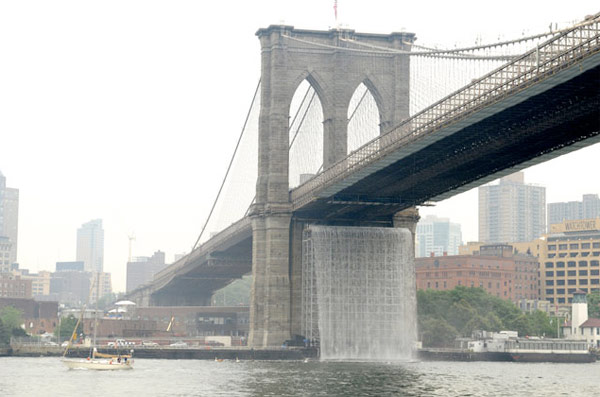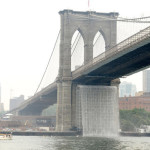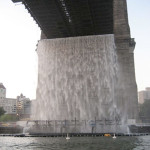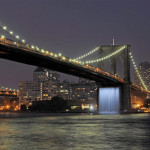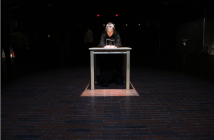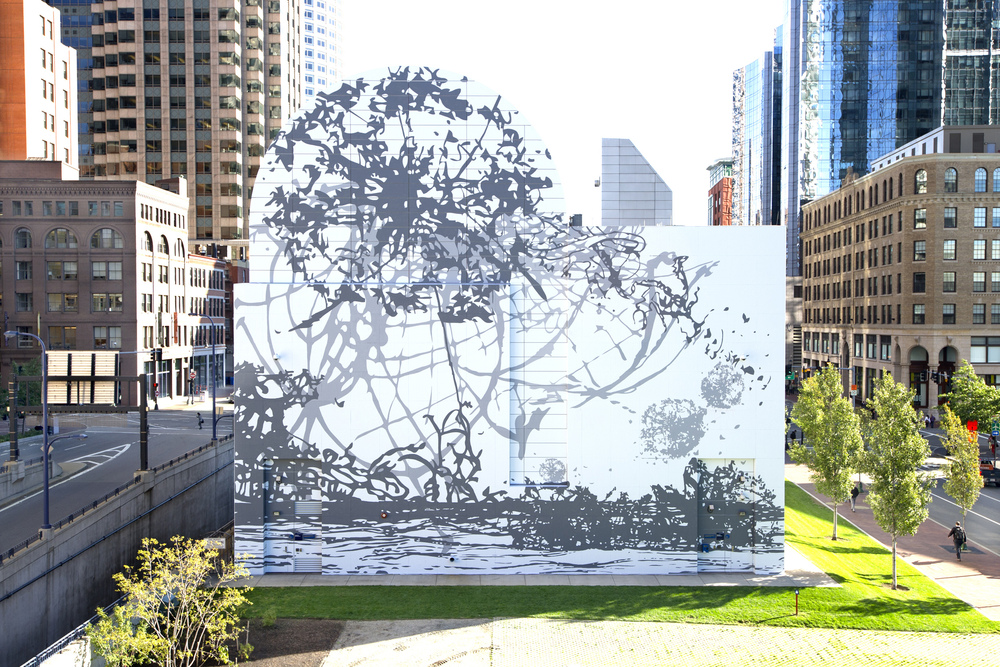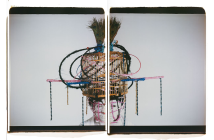OLAFUR ELIASSON: WATERFALLS
I rode over the Manhattan Bridge today with a group of out of towners. As we looked eagerly into New York Harbor for the Eliasson waterfalls, we were disappointed to find only the scaffolding in place, the waterfalls had been turned off. Speculation ran wild. Aside of the more than two dozen government permits acquired to install the piece, provisions to prevent marine life (or over eager kayakers) from being sucked into the system, recent complaints involved the spray of the waterfalls killing plant life on the Brooklyn side. The water source, the East River, is really an estuary, and the salt content is a bit more destructive than originally imaged. As a result, the waterfalls are on for a reduced time than previously determined.
In New York City, much of the natural phenomenon is simulated: Central Park, designed by Frederick Law Olmstead, is almost entirely landscaped, serving changing mid 19th century ideas of parks and human interaction. I recall watching a documentary on Central Park where one of the rangers reached behind a bush to turn off an elegant waterfall spilling into a little pool.
After a few efforts of technology by our group, we discovered that the waterfalls would be turned on at 12:30pm and we made for the third balcony of the South Street Seaport, where all four waterfalls can be seen at once. The two largest waterfalls are installed under the Brooklyn Bridge and on Governor's Island in NY Harbor. Two smaller waterfalls are on the Manhattan and Brooklyn waterfront. Overall, the installations are ambitious, visually stunning, inspiring, and don't quite work.
Christo's "The Gates" installed in Central Park in February 2005 compelled a massive interaction by a public which generally adored the work. While the bright orange sequence of the Gates visually transformed Central Park, the best experience of the piece was the unexpectedly giddy reaction from the public. Observing the piece meant watching the engagement of others: the fun, the play, the tactility - all during the grim winter months in the city. In speaking of the work, Christo regarded the experience of his temporary public art piece to be "democratic" with no hierarchy in place for one person to experience it more than another, and also "like childhood," a time of one's life everyone passes through, but can never return to. While "The Gates" is no doubt a successful piece, I have never been clear as to what the overall meaning of the work might be, aside from vague notions of a "gate" granting passage and removing boundaries.
Eliasson's waterfalls, on the other hand, are a clever confrontation to the spectacle of artifice that comprises the city. Though Eliasson works in a variety of media, his statement of wanting the public to "see themselves seeing" was best demonstrated at his comprehnsive mid-career retrospective at MoMA and PS1 this summer in New York. Those installations, like these waterfalls, invited both a human and mechanical visual interaction: many of the pieces, like "Room for One Color", compel one to take photographs as a means of giving perspective to one's own perception. "What does my camera see...since I'm not sure what I'm seeing" seemed to be a constant refrain.
The proximity of the viewer to the waterfalls may be its major weakness. In reference to the experience of going to a site like Niagara Falls, I've never been, but I imagine that the rush of water becomes totally immersive during the visit- it becomes the whole world: magnificent, powerful, chaotic, scary even. To see Eliasson's waterfalls from such a distance, dwarfed by the distractions of the surrounding city, is a bit of a disappointment. Friends who have taken boat rides past the waterfalls also noted the scale issue, the city can't help but diminish most natural phenomenon in its wake.
Still, Eliasson has done a very interesting thing: an artificial spectacle of natural wonder within the artifice of the metropolis. I'd never noticed before how strange it is that an engineering marvel like the Brooklyn Bridge is made primarily from a natural material, stone. Furthermore, the main ingredient, the water, arises from the what was already there. Eliasson has simply introduced a system where it can be redistributed for visual effect. I'm particularly delighted by the underlying simplicty of the piece, in the face of all the technology, logistics, and money ($15 million), the focus is really on how mesmerizing water can become. (When you go to Niagara Falls, what are you really looking at?) I refer this process to earlier Eliasson works, "Beauty" which is a stream of mist hit with a light producing a rainbow effect, and "The Weather Project" where the focus is a sun-like object glowing in the massive interior of the Tate Modern.
Though the lack of immersion for the viewer is an issue, I imagine many interesting interactions/photographs can be made of the work, which is its own form of participation. This is especially true of the installation under the Brooklyn Bridge, since the bridge has lent itself to so many different iconic visuals over its lifespan.
Now there's a waterfall.
- Three views of Olafur Eliasson’s waterfalls at the Brooklyn Bridge.
The New York City Waterfalls website
"The New York City Waterfalls" is on view June 26 - October 13, 2008.
All images are courtesy of the artist and the New York City Waterfalls website.

